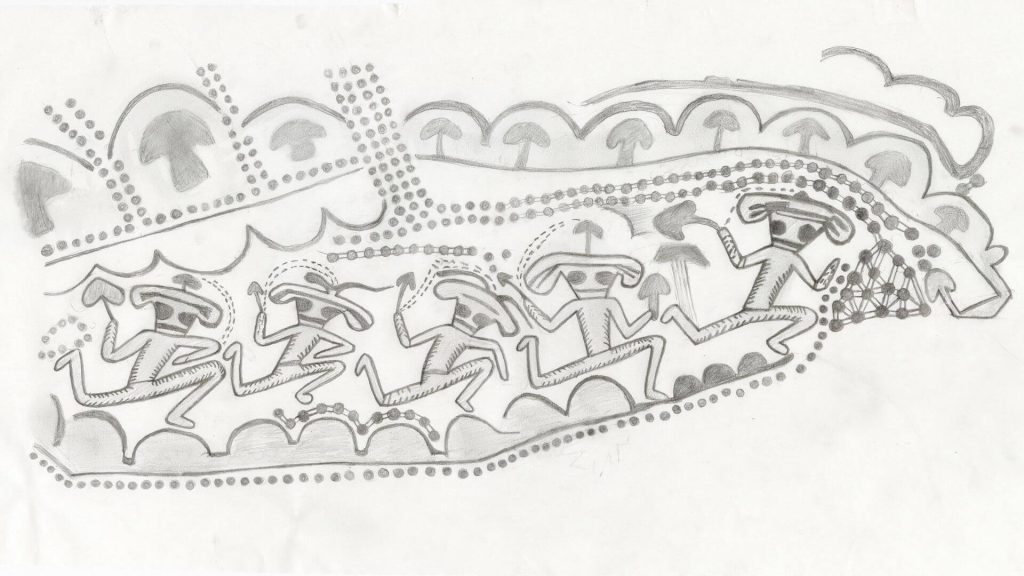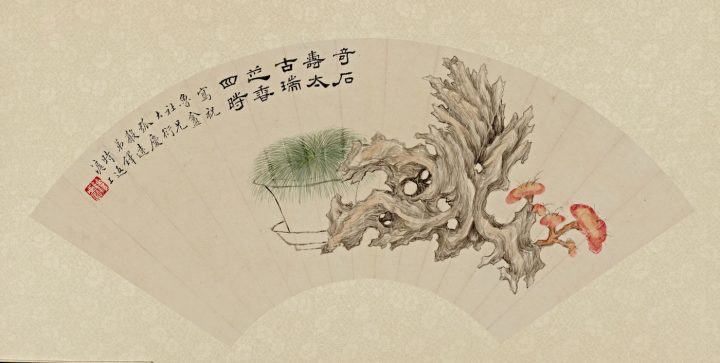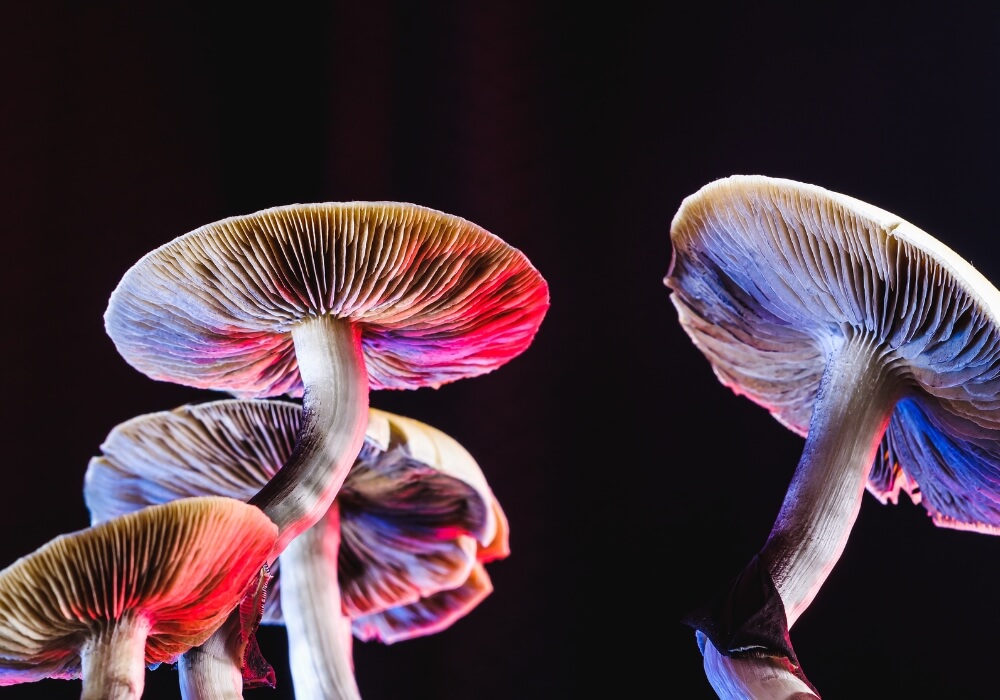From a time before hipsters
Magic mushrooms and other natural psychedelic plants have been used by humans for centuries for rituals and self-enlightenment. Some historians claim that magic mushrooms were used in North Africa as far back as 9000BC (Brusco, 2017), as demonstrated by cave paintings found in the area.
It has long been known that the Aztecs and Maya in central America have used magic mushrooms in ritual ceremonies. There are also arguments that magic mushrooms were used by our linear ancestors, the hominins, and that they played a part in the development of society and the brain (Rodriguez Arce and Winkelman, 2021).
This article will explore more around the history of psilocybin use in cultures all over the globe, how they have been used as a ritual or ceremony and the current landscape of legalization.
History of magic mushrooms
Recent evidence suggests that psilocybe may have arisen on earth right around the same time as the giant asteroid which caused the mass extinction of the dinosours.
A study conducted by the University of Utah and the National History Museum of Utah into 52 psilocybe specimens found that they appeared on planet earth far earlier than previously thought – an astonishing 65 million years ago. Researchers established that “psilocybin was first synthesized in mushrooms in the genus psilocybe, with four to five possible horizontal gene transfers to other mushrooms from 40 up to 9 million years ago.” The scientists and historians involved in this body of research claim it is essential to undergo this kind of molecular research in order to understand the diversity of the compounds in our world and to use the biodiversity to our advantage.
Prehistoric psilocybe use
Magic mushrooms may have been used by our human ancestors to strengthen social bonds and increase empathy.
In an article published in The National Library of Medicine, Rodriguez Arce and Winkelman (2021) claim that psilocybin was used by our hominin ancestors and that it may well have contributed to the evolution of the brain and societies as we know them.
The term ‘hominin’ is used to refer to a group of extinct primates that are known to be part of the human lineage. They are distinguished from other primates by physical characteristics including; larger brains and standing up on two feet, and behavioral characteristics including; using tools and, in some cases, by using language to communicate.
The authors of the paper believe that the psychedelic effects of magic mushrooms were used by our ancestors to open new neural pathways and increase empathy and understanding of others, thus supporting shared goals and strengthening social bonds. They argue that by using psilocybin, social bonds were strengthened through pro-social activities such as laughter, storytelling, music and religion, therefore adapting early humans to live cooperatively with one another and to adapt to their environment.
You may also be interested to learn about Terence McKenna’s “stoned ape theory” from the 1992 book “Food of The Gods“. He theorizes that the transition from Homo Erectus to Homo Sapiens and the cognitive revolution was caused by the addition of psilocybin mushrooms, specifically the mushroom Psilocybe Cubensis, into the human diet around 100,000 years ago. Using evidence largely based on studies from Roland L. Fischer et al. from the 1960s and 1970s, he attributed much of the mental strides made by humans during the cognitive revolution to the effects of psilocybin intake found by Fischer.
Mushroom cave art
There are cave paintings in North Africa and Europe, featuring mushrooms, that date back as early as 9000BC. Although we may never know the truth about these historic cultures, it is suggested, from how the mushrooms are depicted in these paintings, that magic mushrooms were used medicinally, as a connection to the gods, and to enter the spiritual world.
One particular painting found in a cave in Spain shows mushrooms lined up in a row, providing evidence that they were certainly of cultural importance to those who painted them.


Divine mushrooms of the East
Consumption of hallucinogens has been recorded in numerous geographical locations in Asia.
Hindu Sanskrit texts mention ‘Soma’ numerous times, Soma is an elixir thought to contain the amanita muscaria, also known as the fly agaric mushroom.
The amanita muscaria is the dreamy fairytale-like red mushroom with white spots that many of us picture when initially conjuring the thought of a mushroom. The fly agaric mushroom does not produce psilocybin, like other magic mushrooms we are familiar with, but it does have psychoactive effects due to two compounds which combine to create a drunken-like state with both auditory and visual hallucinations.
A sacred text over 3000 years old, the Rig Veda, which remains of great importance to Hindu’s today, talks of the power ‘Soma’ has to connect those who consume it with the gods. The same compound was used by shamans and individuals of indigenous groups thousands of miles to the north, in Siberia, to induce a trance-like state. It is even suggested that Santa Claus as we know him has links to this little red mushroom – the amanita muscaria would pop up under Christmas trees around the winter solstice and shamans would wear red outfits with fluffy collars and trims to collect them. The shaman would return to their cozy yurt which was billowing smoke from the chimney and then proceed to consume and share his mushroom yield with the village.
Ancient Chinese art has many depictions of mushrooms which bestowed people with physical and mental strength.
Such mushrooms can be found in medicinal stores in the present day, but 2000 years ago they were thought only to grow on the mountains in sacred sites. The ‘Lingzhi funghi’ which translates to ‘Divine mushroom’ is prominent in some ancient texts written by numerous philosophers in the East.
They refer to the spiritual power of mushrooms to promote mystical visions, transform consciousness and as a crucial part of spiritual transformation. Eating the mushrooms found on the mountains is said to be one of the greatest connections between humans, nature, and the spiritual realm and it was said that they could lead to personal spiritual strength, longevity or even immortality.

How did the ancient civilisations of the America’s use magic mushrooms?
Findings of statues, paintings and symbols that depict mushrooms, along with paintings of pots overflowing with fermented, bubbling liquid have led to suggestions that the ancient Maya used magic mushrooms medicinally, as well as in rituals and ceremonies. The Maya ate mushrooms in dry, powdered or fresh forms to create visual hallucinations and feelings of connection. There are many claims that the ‘mushroom stones’ were used by a Maya cult for sacrificial purpose (Brusco, 2017). There have also been various accounts, from colonizers, of these mushrooms and other plants being used medicinally and as hallucinogens.
It is commonly thought that mushrooms known as “Teonanácat” to the Aztechs, which translates to “flesh of the Gods”, were in fact magic mushrooms.
Other native American tribes and cultures such as the Mazatecs also have associations with magic mushrooms. A shaft and tomb deep in the ground in Mexico shows a mushroom resembling the hallucinogenic ‘Psilocybe Mexicana’, which adds further evidence to their use in these fascinating societies.

Did amanita muscaria mushrooms create a trance-like rage for the Vikings?
Another group in the Northern Hemisphere known to experiment with amanita muscaria mushrooms are the Vikings. It is suggested that the Vikings used this particular mushroom in rituals to enhance their understanding of the world around them. Some argue the vikings even used them to become more fearless when heading into battle (Schaller and Riphagen, 2022).
The Viking Berserkers were legendary warriors feared by many over the world mostly for their unmatched fury on the battlefield. The amanita muscaria is said to induce a drunk-like state with hallucinations, dilated pupils, increased muscle-tone, delirium, vomiting, tremors, and can act as a stimulant – all of which are consistent with many of accounts of the Viking Berserkers. However, this theory is highly contested amongst historians and ethnobotanists and it has been suggested that other plants could also have induced such a state.
How and when did magic mushrooms arrive in Western culture?
Shrooms arrived in the United states and among Western culture during the 20th century with a helping hand from a banker at J.P Morgan, Gordon Wasson. The banker sampled them on holiday in Mexico and was said to be such a fan that he decided to take them back to the States.
Following his holiday, Wasson wrote an article for Life magazine named “Seeking the Magic Mushroom” (Hill, 2020) based on his experience of using mushrooms in a Mazatec ritual ceremony. This was a major part of the introduction of shrooms to public audiences in Western culture.
In the same year a Swiss scientist, Hoffman (also known as the ‘Father of LSD’), was enlisted to help American scientists study the mushrooms brought back from Mexico by Wasson and he was the first to extract psilocybin from them.
The prohibition of psilocybin and the taboo that followed
During the 1960’s, there was a large amount of research conducted into the effects of psilocybin on humans and its potential benefits, however, this came to a halt in 1970 in the midst of the War on Drugs when it was declared a Schedule 1 substance.
This was the year that President Nixon launched the comprehensive Drug Abuse Prevention and Control Act which, although it’s thought that there were other motives involved in its creation, was set up as an attempt to combat drug addiction, trade, and distribution in the USA. Heroin, LSD, Marijuana and MDMA were amongst the other drugs included on the Schedule 1 list as they are deemed the most dangerous, supposedly causing the greatest harm to society.
This legislation along with social stigma resulted in a large gap in research into the potential benefits and uses of psychedelics in the medical realm.
Where do we stand now with regards to legality around magic mushrooms?
These days we’re seeing a growing interest and debate surrounding the legality of magic mushrooms, with more research being conducted to better understand their effects and potential uses.
In light of the potential medicinal properties of psilocybin, many countries across the world have taken steps to allow trials on the substance. Others have decriminalized or introduced reduced penalties or penalties instead of jail time, however, it still remains illegal for the majority of countries.
Let’s take a look around some of the current world and state legalities around psilocybin…
Oregon is the most progressive state in the USA with regards to their laws around psilocybin. In mid-2023 Oregon opened its first licensed psilocybin service center which enables adults to receive psilocybin-assisted therapy (Halifax, 2022). Most substances, including psychedelics, have been decriminalized in Oregon.
Colorado became the second state to decriminalize psychedelics and in 2024 further progress is set to follow which will enable licensed facilities to administer psilocybin. Further cities within California and Washington have followed suit and decriminalized.
The Netherlands is notorious for its controlled cannabis market and, despite introducing legislation to ban magic mushrooms, a legal loophole means that psilocybin truffles are still widely available.
Other countries where magic mushrooms are legal include Brazil, Jamaica, The Bahamas, Nepal and Peru. The South American countries of Argentina, Ecuador, Chile and Columbia have decriminalized the use of psychedelics.
In Europe, Portugal has decriminalized the use of almost all substances, including psychedelics, which has seen a huge reduction in addiction and crime in the country since a peak in the 1990’s. Other European countries including Spain, Italy, Croatia, Slovenia, Ukraine, Estonia and Latvia have also decriminalized the use of psychedelics and other substances.
Australia has also legalized psilocybin for scientific trials and, as of 2023, psychiatrists can prescribe psilocybin to certain populations.
The last few years has seen significant progress regarding decriminalization and legalization. for scientific studies, treatment of mental health conditions, and recreational use all over the globe and it is likely that more countries and states will follow in the upcoming year.
Magic Mushrooms: a long trip through time
From the Americas to the Far East, evidence shows that humans have been using mushrooms for thousands of years. It’s fascinating to see how magic mushrooms have shaped today’s people, beliefs, and the sense of communities in cultures all over the world.
The key theme highlighted throughout the use of mushrooms in history is their ability to broaden one’s perspective, create a sense of community and understanding and to connect the physical and spiritual worlds.
Progress has been made with regards to legalization and decriminalization since their prohibition. Many states and countries are decriminalizing possession of magic mushrooms and enabling research into the benefits they can provide from both a mental health and physical treatment perspective.
The long history of psilocybin and emerging research into its therapeutic properties are helping the world to see magic mushrooms in a new light. It seems undeniable that mushrooms will continue to have a place in the future of human evolution, art, and medicine all over the world.
Works Cited
“,.” , – YouTube, 13 November 2023, https://www.nejm.org/doi/10.1056/NEJMoa2206443. Accessed 13 January 2024.
Barron, Madeline. “Psilocybin and Mental Health: The Magic in the Mushrooms.” American Society for Microbiology, 10 February 2023, https://asm.org/articles/2023/february/psilocybin-and-mental-health-the-magic-in-the-mush. Accessed 13 January 2024.
Brusco, Robert. “Tripping through Time: The Fascinating History of the Magic Mushroom.” Ancient Origins, 1 February 2017, https://www.ancient-origins.net/history-ancient-traditions/tripping-through-time-fascinating-history-magic-mushroom-007474. Accessed 13 January 2024.
Campbell, Olivia. “What does Santa have to do with … psychedelic mushrooms?” National Geographic, 21 December 2023, https://www.nationalgeographic.com/environment/article/santa-claus-magic-mushroom-legend. Accessed 5 February 2024.
“Continental Focus: Psychedelics in Asia – Part 1 – PSYCH.” Psych Global, 12 May 2021, https://psych.global/continental-focus-psychedelics-in-asia-part-1/. Accessed 5 February 2024.
Fontaine, Dominique, and Kathleen Davis. “Psilocybin and magic mushrooms: Effects and risks.” Medical News Today, 2023, https://www.medicalnewstoday.com/articles/308850#what-is-psilocybin. Accessed 15 January 2024.
Hallifax, James, and Darrell Dorsett. “6 Countries Where Psychedelics Are Legal (Updated 2023).” Psychedelic Spotlight, 13 July 2022, https://psychedelicspotlight.com/6-countries-where-psychedelics-are-legal/. Accessed 13 January 2024.
Mance, Henry. “Entangled Life — of mushrooms, magic and more.” Financial Times, 25 August 2020, https://www.ft.com/content/02ffae1d-c5de-4fac-926d-b84b47a6fb44. Accessed 7 February 2024.
McSwine, Damien. “.,.” ., – YouTube, 7 November 2023, https://www.nejm.org/doi/10.1056/NEJMoa2206443. Accessed 13 January 2024.
Potter, Lisa. “Psychoactive psilocybin’s evolution in ‘magic mushrooms’ – @theU.” @theU, 9 January 2024, https://attheu.utah.edu/facultystaff/psychoactive-psilocybins-evolution-in-magic-mushrooms/. Accessed 5 February 2024.
Rodriguez Arce, Jose Manuel, and Michael James Winkleman. “Psychedelics, Sociality, and Human Evolution – PMC.” NCBI, 29 September 2021, https://www.ncbi.nlm.nih.gov/pmc/articles/PMC8514078/. Accessed 13 January 2024.
Schaller, Jennifer, and Joyce Riphagen. “Vikings might have gone berserk with magic mushrooms, historians say.” The Daily Cardinal, 10 November 2022, https://www.dailycardinal.com/article/2022/11/vikings-might-have-gone-berserk-with-magic-mushrooms-historians-say. Accessed 13 January 2024.
Voon, Claire. “Hunting for the Magic Mushrooms of Ancient East Asian Art.” Hyperallergic, 28 April 2017, https://hyperallergic.com/367509/hunting-for-the-magic-mushrooms-of-ancient-east-asian-art/. Accessed 5 February 2024.
- SEO Powered Content & PR Distribution. Get Amplified Today.
- PlatoData.Network Vertical Generative Ai. Empower Yourself. Access Here.
- PlatoAiStream. Web3 Intelligence. Knowledge Amplified. Access Here.
- PlatoESG. Carbon, CleanTech, Energy, Environment, Solar, Waste Management. Access Here.
- PlatoHealth. Biotech and Clinical Trials Intelligence. Access Here.
- Source: https://cbdincubator.com/mycology/ancient-rituals-to-modern-policies/



